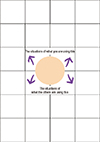INTRODUCTION
PARTICIPATION
1. Being accustomed to the ideation, sharing and realizing what better ideas there are
The participants got a paper, which was called 'situation-blank', individually (Fig. 2). This method was made by IMAGINE Lab in Hanyang University. It was modified from a design method 'Mandal-art' [16]. 'Mandal-art' is a tool which easily extends ideas by being filled with blank [16]. In the situation blank, there are 20 blanks. Half of the blanks are used to describe the conditions of who are using a particular object: 'I'-part. The rest of them are for the conditions what the other people are using the product: 'You'-part.
The moderator chose an object randomly (we used a bed in the workshop). Then s/he showed the way s/he come up with the ideas with the 'situation box' briefly (e.g., 'I am watching TV on the bed', 'My mother plays 'Whato' on the bed'). The participants got 15 minutes and drew or write their ideas in the blanks (Fig. 3). If the participants fill in the blanks too slowly, the moderator reminds the participant about the time limit.
After filling in the blanks, all the participants shared their ideas taking turns. Because Asperger's syndrome participants have a communication problem, we observed many wandering ideas by some participants. To ease such tensions, the moderator intervened several times.
The moderator gave a problem that they need to solve and it was modified from the popular 'marshmallow challenge' (Fig. 5). In the marshmallow challenge, the participants need to make one marshmallow at the highest point using marshmallows and spaghetti noodles within 7 minutes. And there were no other rules given.
After finishing the challenge, the moderator suggested the expansive solution examples for the marshmallow challenge. For instance, the moderator suggested that the way of attaching the marshmallow on the ceiling and lifting the table at the time of measuring the highest point of the marshmallow.
With giving expansive examples, the moderator taught what the functional fixedness is about and what better ideations are. The aim of activity 2 in stage one was to make the asperger's syndrome participants look at their idea objectively and stimulate them to strive for better ideas.
2. Generating the real design source for expert designer
The moderator gave more than 100 images from four different topics of magazines such as cooking, living, man, and woman. First of all, the moderator and the participants saw the images together and just talked about their feeling when they see the images. Fig. 6 shows that the participants sharing their thoughts about the images.
The moderator introduced a product. Because the expert designer who participated in this workshop was from a car industry, the moderator suggested a 'toy car'. The moderator gave time to think about the car to the participants.
The moderator gave directions as follows: please, put the toy car in the middle. Then attach the images you get from the magazines around the toy car. Whenever you attach the images, you need to explain (1) why you choose this image, and (2) why you put the image in that position.
For 15 minutes, the participants conducted the design method freely.




 PDF
PDF ePub
ePub Citation
Citation Print
Print









 XML Download
XML Download